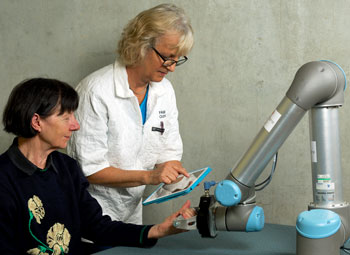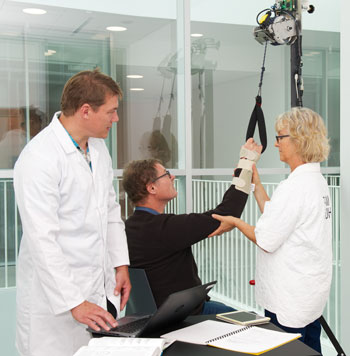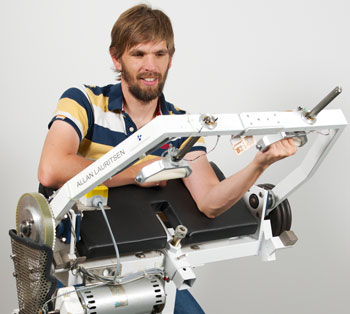Welfare technology can help people with health-related challenges so that they can carry on with their normal everyday life despite physical impairments. At The Maersk Mc-Kinney Moller Institute at the University of Southern Denmark (SDU), research is being carried out into how industry robots or rope pulling robots can be used as innovative solutions for rehabilitation.
We are collaborating with companies, patient associations, health personnel, research institutions, etc. 
Rehabilitation of the future with industry robot (Universal RoboTrainer)
Research has shown that an industry robot from Universal Robots has great potential as a training partner for patients with injuries caused by stroke.
An industrial robot arm as an effective training partner
The robot is being used as a training partner since studies have shown that numerous repetitions of training exercises are an effective way of helping the brain to learn to control paralysed muscles so that functional ability gradually returns. Depending on the nature of paralysis, patients are often not able to do the exercises without help from physiotherapists but with the help of a robot arm, patients can perform the exercises required for rehabilitation themselves. The therapist and patient record the desired training path by means of the robot. These recordings become the foundation of the patient’s rehabilitation and as the patient gains arm strength, the amount of help from the robot can be reduced. The robot's sensors evaluate how much help the patient needs, thereby ensuring that the exercise is neither too difficult nor too easy but adapted to the appropriate level required by the patient.
Targeted and motivational training
The project also focuses on making it easy for physiotherapists to create individual training programs for individual patients. At the same time researchers are looking at how robot training can be made more motivational to ensure effective rehabilitation. The aim is to provide a good insight into what is required technologically in order to convert industry robots into rehabilitation partners.
Robot training helps the weakest patients (RoboTrainer Light)
 Rehabilitation is crucial for patients who have become disabled as a result of a stroke or an accident. But if the patient is too weak to undertake ordinary rehabilitation, RoboTrainer Light can help. The goal here is to develop affordable technology for home use by patients too weak to use ordinary training machines.
Rehabilitation is crucial for patients who have become disabled as a result of a stroke or an accident. But if the patient is too weak to undertake ordinary rehabilitation, RoboTrainer Light can help. The goal here is to develop affordable technology for home use by patients too weak to use ordinary training machines.
Easy to use and transport
RoboTrainer Light is a simply constructed rope pulling robot and consists only of a nylon rope and a computer-controlled motor. There is a loop at the end of the nylon rope that the patient can put his/her hand in. The computer sits inside a wheel track which the nylon rope runs around. The motor helps raise the arm and as the patient progresses further with the rehabilitation process, the motor can be adjusted to give less help or give the arm more resistance so the patient needs to use force to pull the rope down again. RoboTrainer Light is easy to transport and set up.
The projects are part of Denmark's largest welfare technology research and innovation project, Patient@home.
Read more about Universal RoboTrainer and RoboTrainer Light.
About the research Group
At The Maersk Mc-Kinney Moller Institute, a welfare technology group led by Associate Professor Anders Stengaard Sorensen and his colleagues are carrying out research into robot-assisted training by means of robot technology and sensor technology with biofeedback.
The welfare technology group is constantly developing new, innovative methods and tools that can improve the quality and effectiveness of rehabilitation. In addition, the group is participating in several innovation projects where collaboration with health personnel, patients and private companies is initiated as early as possible to create the right foundation for the different initiatives.
Contact persons
Associate Professor Anders Stengaard Sorensen, email: anss@mmmi.sdu.dk
Associate Professor Jacob Nielsen, email: jani@mmmi.sdu.dk
Coordinator Conny Heidtmann, email: cohe@mmm.sdu.dk
Background of the RoboTrainer projects
The original RoboTrainer was the initiative of Allan Lauritsen, who successfully recovered from an accident that crushed bones and muscles in his arm, shoulder and leg. Despite the surgeon’s prognosis, Allan has regained most of his physical abilities due to an extreme training program, designed by himself, and carried out over many years.
Allan Lauritsen approached RoboLab in order to discuss the possibility of developing a robotic training partner, and soon after a proto type – RoboTrainer – was developed. The mechanical design was carried out by Allan Lauritsen while researchers from SDU were responsible for the electronic design, implementation and programming.
Photo: H. K. Hannibal-Bach